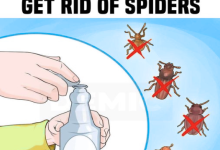We’ve collected “golden rules” of cleaning we think you may find helpful. If you stick to these rules, you get your cleaning done quickly and effortlessly.
1. Clean it up sooner rather than later

Spills and stains are generally much easier to clean up when you attack them right away.
If you treat a stain without delay it offers little resistance, but wait until the next day and it’ll be much tougher to get out.
The rare exception to this rule is mud that has been tracked onto your carpet. Mud is easiest to clean when you’ve let it dry first. Wait until it’s bone dry and crumbly, then just vacuum it up.
2. Clean from the top down

Don’t fight gravity when you clean. You’ll lose. Working from high to low almost always works better in cleaning situations.
When you’re cleaning the entire house, start on the top floor and work your way down to avoid tracking through rooms you have already cleaned.
When you’re cleaning a room, first remove the cobwebs from the ceiling and upper molding. Then dust the ceiling fan and light fixtures, followed by window frames and wall hangings. Moving downward, conquer the furniture, baseboards, and floors. This ensures that any dust shaken loose from on high does not settle on something you’ve already cleaned below. You don’t want to dust the room twice, do you?
Similarly, when you clean windows and mirrors, start-up high and work your way down, because your cleaner obeys gravity. This saves you elbow grease and time.
The rare exception to this rule is wall washing. If you start at the top when you’re washing a wall in your home, dirty water will drip onto the lower areas you haven’t cleaned yet, making streaks that will be tough to remove.
3. Think dry, then wet

When you’re cleaning a room, start with the cleaning jobs that require dry methods (dusting, sweeping, and vacuuming, for instance). Then move on to wet methods (using an all-purpose cleaner and glass cleaner, mopping, and the like). This way, there will be less dirt floating around in the room to cling to wet surfaces.
4. Start with the least harmful approach

Use your gentlest cleaning methods first and move up to more aggressive techniques only if necessary. And know your materials well enough so that you will stop your cleaning efforts before you do damage. Better to suffer along with a small spot on your stovetop, for instance, than to ruin the surface with steel wool.
5. Let time do the work for you

A little time management trick will make your cleaning easier and faster. When you plot out your approach to a cleaning task, remember to spray on your cleaning chemicals first and then find another little job to do while the cleaner does its dirty work. If you’re cleaning in the kitchen, for instance, spray your cleaner on the counter and appliances, then occupy yourself with removing old food from the refrigerator while the cleaner soaks in. When you come back to wipe clean, there will be little or no scrubbing to do.
6. Carry your supplies with you

Carry your core cleaning products with you. This will save you from making multiple trips around the house looking for the right tools and cleaners. Pick up one of these accessories at a home improvement store or hardware store:
- A cleaning caddy — a plastic or rubber carrier with a handle and compartments for holding your gear
- A sturdy, large plastic bucket with a good handle
- A rolling supply cart
- An apron with roomy pockets
Put all of your cleaning supplies into the receptacle you’ve chosen, including clean rags, paper towels, and a trash bag for emptying all of those wastebaskets, and cart it with you from room to room. If your house has more than one floor, keep a fully stocked caddy on each level.
Don’t weigh your carrier down with specialty products that are needed for only one job around the house. Store toilet bowl cleaner, for instance, under the bathroom sink.
7. When in doubt, make a stealth test

Before you use a new cleaning technique or product, test the method on an inconspicuous area of the object you’re cleaning. This rule also applies when you first clean an object that is delicate and might be damaged by a cleaning compound. Testing will show you whether the object is colorfast and whether the cleaning method is likely to do damage.
8. Use cleaning liquids sparingly
When you clean an item that could be harmed by a liquid cleaning product, like electronics, computer screens, framed artwork, or framed photographs, first spray the cleaner on your cleaning cloth and then wipe.
Don’t spray cleaner directly on the object you’re cleaning.
9. Read the instructions

Follow the manufacturer’s instructions when cleaning anything to avoid causing damage.
File the instructions and cleaning tips that come with any new appliance, rug, or other household items, and similarly don’t remove those care labels that come on clothes, linens, and any other potentially washable objects.
10. Protect yourself

Many of the cleaning products you use contain acid, bleach, abrasives, and other ingredients that can damage your eyes, skin, nose, and even your lungs, so make sure you use rubber gloves and protective safety glasses when necessary.
If it’s not too hot, wear old long pants or tracksuit pants and an old long-sleeved shirt to cover your arms in case of spatters from cleaning products. Cover your hair with a scarf or baseball cap.
It is also important that you don’t let your cleaning products get mixed together. Some chemical combinations, chlorine bleach, and ammonia, for example, will produce poisonous gases. As an extra safety precaution when you’re using cleaning chemicals, make sure the room you’re in is properly ventilated.







